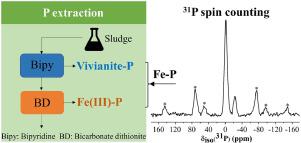Water Research ( IF 11.4 ) Pub Date : 2021-07-07 , DOI: 10.1016/j.watres.2021.117411 Qian Wang 1 , Tae-Hyun Kim 2 , Kasper Reitzel 3 , Nina Almind-Jørgensen 4 , Ulla Gro Nielsen 1

|
Vivianite (Fe3(PO4)2⋅8H2O) is a potential phosphorus (P) recovery product from wastewater treatment plants (WWTPs). However, routine methods for quantification of vivianite bound P (vivianite-P) are needed to establish the link between vivianite formation and operating conditions, as current approaches require specialized instrumentation (Mössbauer or synchrotron). This study modified a conventional sequential P extraction protocol by insertion of an extraction step (0.2% 2,2′-bipyridine + 0.1 M KCl) targeting vivianite-P (Gu et al., Water Research, 2016, 103, 352–361). This protocol was tested on digested and dewatered sludge from two WWTPs, in which vivianite (molar Fe:P ratios of 1.0–1.6) was unambiguously identified by optical microscopy, powder X-ray diffraction, and scanning electron microscopy with energy dispersive X-ray spectroscopy. The results showed that vivianite-P was separated from iron(III)-bound P (Fe(III)-P) in the sludge. Vivianite-P constituted about half of the total P (TP) in the sludge from a Fe dosing chemical P removal (CPR) WWTP, but only 16–26% of TP in the sludge from a WWTP using a combination of Fe dosing CPR and enhanced biological P removal (EBPR). The modified protocol revealed that Fe-bound P (Fe-P, i.e., vivianite-P + Fe(III)-P) was the dominant P fraction, in agreement with quantitative 31P nuclear magnetic resonance (NMR) experiments. Moreover, it was shown that the conventional P extraction protocol underestimated the Fe-P content by 6–35%. The established protocol represents a reliable in-house analytical method that can distinguish and quantify vivianite-P and Fe(III)-P in sludge, i.e. facilitate optimized vivianite production at WWTPs.
中文翻译:

通过 PXRD、SEM-EDS 和 31P NMR 光谱验证的磷酸盐提取方案定量测定污水污泥中的紫铁矿,以实现高效紫铁矿回收
紫铁矿 (Fe 3 (PO 4 ) 2 ⋅8H 2O) 是来自废水处理厂 (WWTP) 的潜在磷 (P) 回收产品。然而,需要对紫铁矿结合 P (vivianite-P) 进行量化的常规方法来建立紫铁矿形成和操作条件之间的联系,因为当前的方法需要专门的仪器(穆斯堡尔或同步加速器)。本研究修改了传统的连续 P 提取方案,通过插入一个提取步骤(0.2% 2,2'-联吡啶 + 0.1 M KCl)针对紫铁矿-P(Gu et al., Water Research, 2016, 103, 352–361) . 该方案在来自两个污水处理厂的消化和脱水污泥上进行了测试,其中通过光学显微镜、粉末 X 射线衍射和具有能量色散 X 射线的扫描电子显微镜明确识别出紫铁矿(Fe:P 摩尔比为 1.0-1.6)光谱学。结果表明,紫铁矿-P与污泥中的铁(III)结合的P(Fe(III)-P)分离。Vivianite-P 占 Fe 投加化学除磷 (CPR) WWTP 污泥中总磷 (TP) 的一半左右,但使用 Fe 投加 CPR 和增强生物除磷 (EBPR)。修改后的方案表明,与铁结合的 P(Fe-P,即紫铁矿-P + Fe(III)-P)是主要的 P 部分,与定量分析一致31 P核磁共振(NMR)实验。此外,结果表明,传统的 P 提取方案低估了 Fe-P 含量 6-35%。已建立的协议代表了一种可靠的内部分析方法,可以区分和量化污泥中的 vivianite-P 和 Fe(III)-P,即促进优化污水处理厂的 vivianite 生产。










































 京公网安备 11010802027423号
京公网安备 11010802027423号